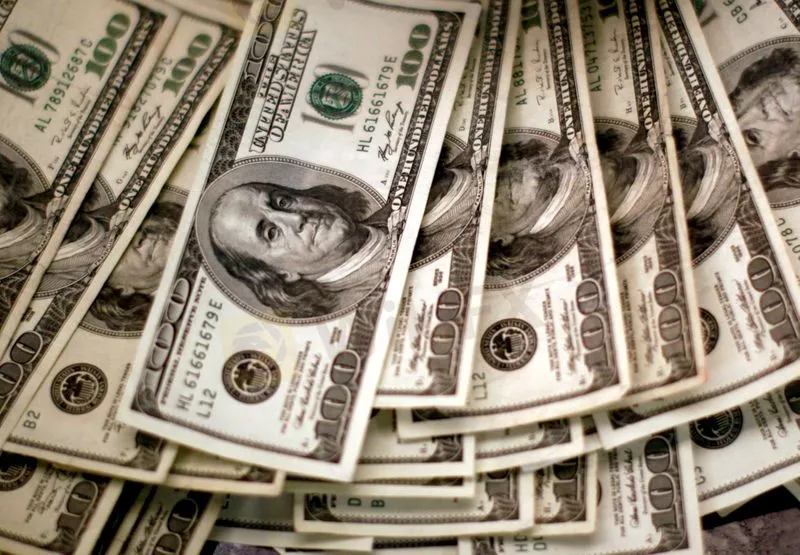简体中文
繁體中文
English
Pусский
日本語
ภาษาไทย
Tiếng Việt
Bahasa Indonesia
Español
हिन्दी
Filippiiniläinen
Français
Deutsch
Português
Türkçe
한국어
العربية
Dollar hits 16-month high as inflation fears set it up for best week since June
Abstract:The U.S. dollar headed for its best week in almost five months against major peers on Friday, amid bets for earlier Federal Reserve interest rate hikes after data this week showed the fastest U.S. inflation in three decades.

The U.S. dollar headed for its best week in almost five months against major peers on Friday, amid bets for earlier Federal Reserve interest rate hikes after data this week showed the fastest U.S. inflation in three decades.
The dollar index, which measures the currency against six peers, hit a fresh 16-month high of 95.266, on track for a 1.05% gain this week, the most since the period ended June 20.
The euro slipped back to a 16-month low at $1.1436, and sterling dipped to $1.3354, its weakest level this year.
“We close out the week with the USD thoroughly breaking out,” Chris Weston, head of research at brokerage Pepperstone, wrote in a client note. “I am seeing signs of an impending mean reversion play in the USD, but in this flow, dips are a buying opportunity.”
Data on Wednesday showed a broad-based rise in U.S. consumer prices last month at the fastest annual pace since 1990, calling into question the Fed's contention that price pressures will be “transitory” and fuelling speculation that policymakers would lift interest rates sooner than previously thought.
Markets now price a first rate increase by July and a high likelihood of another by November.
“We still think market pricing has room to firm further, especially in 2023, which can further support USD,” Commonwealth Bank of Australia (OTC:CMWAY) strategist Kimberley Mundy wrote in a client note.
By contrast, “interest rate futures are too aggressive in pricing in (European Central Bank) rate increases for next year considering ECB policymakers are not budging from their ultra‑dovish guidance,” giving scope for further euro weakness, she said.
Traders will be watching inflation readings from a University of Michigan survey, along with JOLTS job openings data later in the global day.
New York Fed president John Williams speaks at an online conference, potentially offering a glimpse of how policymakers are reacting to the red-hot inflation print.
European Central Bank chief economist Philip Lane also speaks on a panel at a separate event.
The dollar rose as high as 114.30 yen on Friday, the strongest since Nov. 1.
It touched a three-week high of 0.92295 Swiss franc.
Swiss National Bank governing board member Andrea Maechler said at an event late on Thursday the Swiss franc remained in demand as a safe haven investment with market uncertainties elevated due to the ongoing COVID-19 pandemic.
The risk-sensitive Australian dollar sank as low as $0.7277 for the first time in more than a month.
The New Zealand dollar dropped as low as $0.69965, a level not seen since Oct. 14.
In crypto, bitcoin traded just south of $65,000, down from a record $69,000 earlier in the week.
Ether changed hands at around $4,800,within sight of the all-time peak of $4,868.79 reached Tuesday.
Source: Investing.com

Disclaimer:
The views in this article only represent the author's personal views, and do not constitute investment advice on this platform. This platform does not guarantee the accuracy, completeness and timeliness of the information in the article, and will not be liable for any loss caused by the use of or reliance on the information in the article.
Read more

Economic and Political Shifts Impact Global Markets Part 2
Recent developments include President Biden's potential re-election reconsideration, Asia-Pacific market highs, PwC's auditing issues in China, potential acquisitions in the energy and retail sectors, geopolitical tensions, and regulatory actions impacting markets. Key impacts include fluctuations in USD, CNY, CAD, TWD, EUR, GBP, and AUD, with significant effects on stock markets across the US, Asia, and Europe.

Economic and Political Shifts Impact Global Markets Part 1
Recent developments include President Biden's potential re-election reconsideration, Asia-Pacific market highs, PwC's auditing issues in China, potential acquisitions in the energy and retail sectors, geopolitical tensions, and regulatory actions impacting markets. Key impacts include fluctuations in USD, CNY, CAD, TWD, EUR, GBP, and AUD, with significant effects on stock markets across the US, Asia, and Europe.

GEMFOREX - weekly analysis
Top 5 things to watch in markets in the week ahead

GEMFOREX - weekly analysis
The week ahead: 5 things to watch
WikiFX Broker
Latest News
AIMS Broker Review
The Hidden Checklist: Five Unconventional Steps to Vet Your Broker
Russia to Fully Ban Crypto Mining in 10 Regions Starting January 1, 2025
YAMARKETS' Jingle Bells Christmas Offer!
Why is there so much exposure against PrimeX Capital?
Doo Financial Expands Regulatory Reach with Offshore Licenses in BVI and Cayman Islands
MTrading’s 2025 "Welcome Bonus" is Here
Doo Financial Obtains Licenses in BVI and Cayman Islands
CFI’s New Initiative Aims to Promote Transparency in Trading
Currency Calculator


